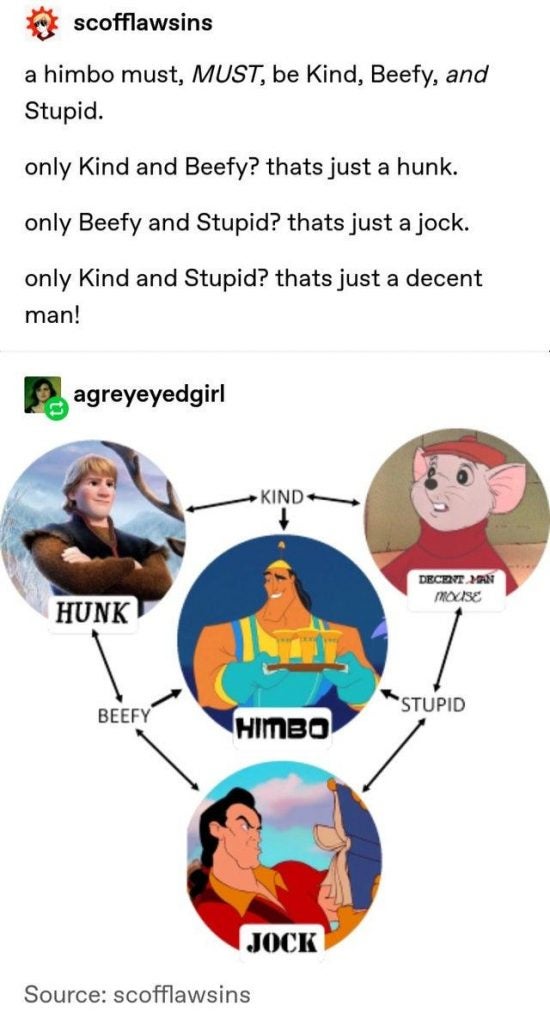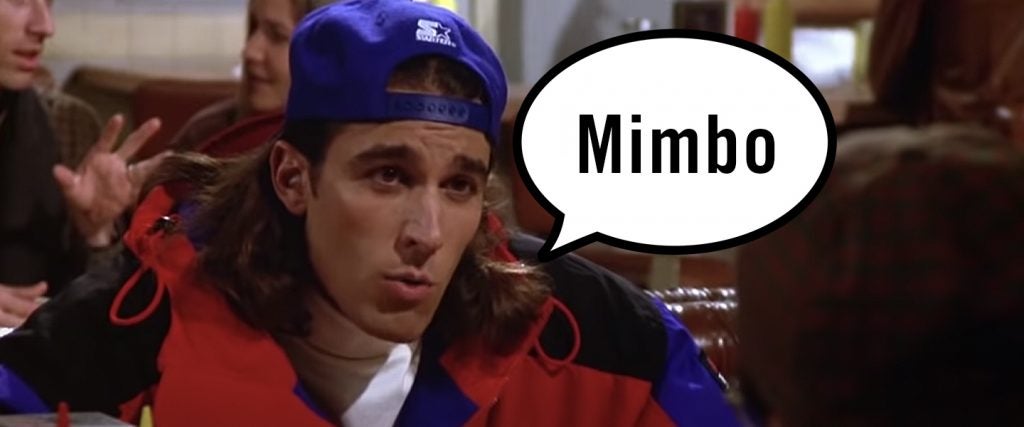From “shrinkage” to “double-dipper” to the annual celebration of Festivus, Seinfeld has impacted the American lexicon in an untold number of ways. However, there’s one word from the show’s fifth season that was custom-built for the American tongue, yet it never really made it past the episode itself. I’m talking, of course, about “mimbo,” Jerry’s word for a “male bimbo,” which has clearly lost out to the much more widely accepted “himbo.” This begs the question: Given Seinfeld’s outsized impact on our culture and language, how did mimbo get the short end of the stick?
The term “mimbo” was first presented by Jerry in a 1994 episode called “The Stall.” In it, Elaine is dating a guy named Tony, a good-looking, tough-talking rock-climber who doesn’t seem all that bright. Jerry explains to Elaine that Tony is “a male bimbo. He’s a mimbo.” Not only does Jerry say it, but Elaine also repeats the word back to him, and says it twice more later on in the episode.
According to the Nielsen ratings from that week, a stunning 32.8 million people watched “The Stall” when it first aired, and countless more have watched it since. Yet despite a few stalwart Seinfeld fans using the word and a sorry-looking Urban Dictionary entry about it, mimbo is nowhere near as popular as himbo.
Himbo, meanwhile, had somewhat humbler beginnings. First uttered in 1988 in the Washington Post, the term was coined by film critic Rita Kempley to describe an audience member at Cannes who was acting like a “macho himbo” as he strutted the Croisette wearing a “16-foot python like a stole around his shoulders and neck.”
A couple of weeks later, Kempley described the term in a piece called “The Himbo All Powerful and All Beef! It’s the Reel Men!!!” The article, rather poetically, begins as follows: “Their chest measurements rival Dolly Parton’s. Their brains would embarrass a squid. They ballyhoo Maidenform undies, do nude scenes and are wildly popular with both girls and boys. They come in two varieties — greased and armed-to-the-teeth or moussed and undressed-to-die-for. They’re bombshells with a Y chromosome. Bimbo begone! Hollywood has blessed us with the Himbo.”
Usage of the word “himbo” didn’t stop with Kempley, as it would also appear in at least two books from the 1990s which examined the sociological appeal of the himbo. In April 1995, a year after “mimbo” was uttered on Seinfeld, CNN opted to use the word “himbo” in a segment called “Hollywood Hunks — Just a Bunch of Himbos?” In the piece, Sherri Sylvester did a bit on male action stars, and even cited a 1994 quote from Keanu Reeves about the term: “There’s a great word. What is it? A himbo? Yeah, himbo. I love that word. I read that and laughed my head off.”
At the time of the Washington Post piece and the CNN segment, each publication had a reach of about 769,000 and 650,000 people, respectively. Even combined, that’s far less than the 32.8 million Seinfeld viewers when “The Stall” first aired, plus the immeasurable repeat viewings in syndication, on DVD and via streaming services. Nevertheless, in 2006, himbo was added to the Merriam-Webster Dictionary, while mimbo is still nowhere to be found in its pages.
Then, beginning in the fall of 2019 and a year later in 2020, there was a himbo explosion, where the word was suddenly everywhere online. It’s hard to know what started it, but Know Your Meme points to several popular tweets from the time, as well as some online videos and some Tumblr discourse. One of the best memes compares different Disney characters and explains why Kronk from The Emperor’s New Groove is the perfect himbo.

Still, the question persists. Since the mid-1990s, Seinfeld has never significantly dipped in popularity, so one might think that “mimbo” would have been primed to meet the moment in late 2019. Instead, himbo won out and cemented itself in our vernacular. Why? Is it enough to say that himbo triumphed simply because it came first? Etymologist Mark Peters, author of the book Bullshit: A Lexicon, doesn’t think so. “Seinfeld should’ve given ‘mimbo’ an advantage,” he says, “but I think ‘himbo,’ regardless of age, is a better-built word.”
He goes on to explain that “mimbo’ has the ‘m’ for ‘men,’ [or ‘male,’ as Jerry said] but ‘himbo’ contains the entire pronoun ‘him.’” Per Peters, that makes it a more clever, understandable coinage, which plays a big role in the success and longevity of words. “The key factor is that ‘himbo’ can be understood by a newbie in about a nanosecond, while ‘mimbo’ is slightly less transparent,’” he says.
Peters cautions that his answer is speculative, but it does make perfect sense. Just think back to the Seinfeld scene — Jerry had to explain mimbo to Elaine. However, when Kempley introduced the term in May 1988, she did so without explanation. Even when she expanded on the term later, it was more to define types of himbos, not the word itself. So it didn’t matter how popular Seinfeld was, or continues to be — “himbo” is by far the better word. It’s melodic, easy to say and most importantly, easy to understand — so simple, in fact, that even a himbo can get it.

